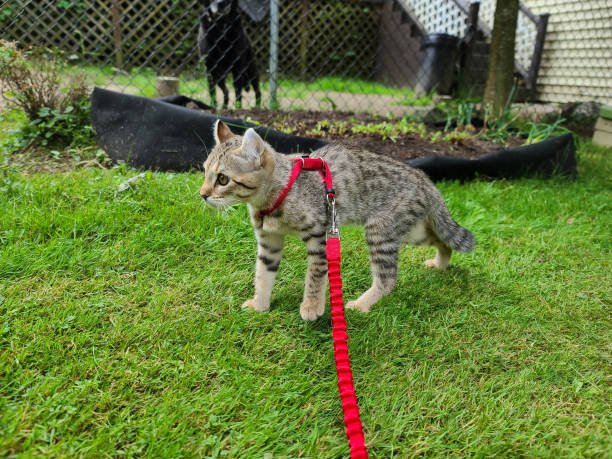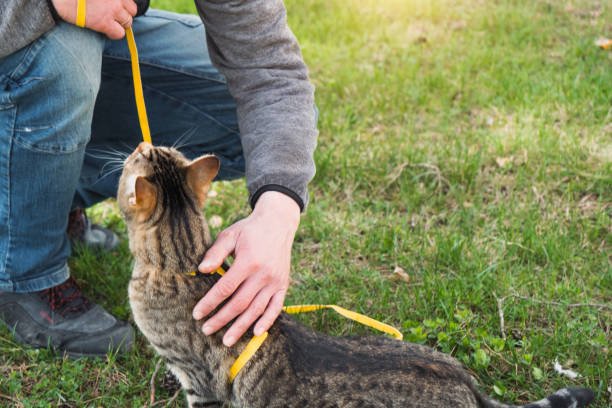- What is the best age to start leash training?
Kittens as young as 8-12 weeks old can start leash training. Younger kittens tend to adapt more easily than older cats.
- What type of leash and harness should I use?
Use a lightweight, adjustable harness designed specifically for cats and a non-retractable leash to maintain control.
- Is leash training suitable for all cats?
Most cats can be leash-trained, but some may not enjoy it. Always consider your cat’s temperament and comfort level.
Leash Training for Your Cat
Author Fakhir Zia Update 04/12/25
Published by M Taha Ali

Leash training unlocks opportunities for safe exploration, letting even a cat who loves snoozing indoors experience the outdoors. Begin leash training a cat early by introducing a harness gently, allowing your curious kitten or relaxed feline to adapt. This process enriches a cat’s life by letting them safely enjoy sights and avoid dangers like traffic and urban hazards.
Over plenty of time, this practice keeps them happy, mentally stimulated, and physically stimulated, no matter their temperament. Pet parents can turn short walks into exploring adventures, nurturing their furry companions’ attitude toward the outside world.
Whether raising an adventure cat or easing a cautious pet, shared experiences strengthen bonds and prevent boredom. Patience is key, celebrate small wins, and let curiosity guide the journey.
Leash Training Cat Tips & Benefits
Training will enriches your indoor cat’s life by safely expanding their environment outdoors, offering both exercise and mental stimulation. Using a proper harness and lightweight leash, gradually introduce your cat to the outdoors with positive reinforcement and patience. This process boosts their confidence, strengthens your bond, and keeps them safely engaged in a world beyond four walls.
Benefits of Leash Training
When cats are kept indoors, they can experience a sedentary life, which limits their ability to explore and fulfill their natural curiosity. Unlike community cats roaming across 150 acres, indoor cats have a limited area, often under 40 square yards to call their own. This can lead to boredom, which affects their mental health and can contribute to problems like obesity.
Using a harness and leash, pet parents let cats safely explore outdoors, providing opportunities to walk, exercise, and discover. This reduces the risks of catfights, diseases, injuries, and harsh weather, keeping kitties safe while they enjoy the outdoors Many cat owners report that their cats become more confident and playful after regular leash walks.
It provides physical benefits and boosts mental stimulation, combating boredom from limited indoor living. Sharing adventures strengthens the bond between pet parents and their cats while exploring new places and meeting others. Leash walks boost your cat’s confidence and maintain their mental balance, whether around the block or further afield.
How to leash train a cat

Leash train a cat differs from dog walking; expect a unique experience. Unlike dogs, cats may take the lead, stopping to play, sniff, and explore along the way. They might even sprint excitedly if they spot something interesting like a bug. Training will take time and patience, but the key is being prepared to let your cat set the pace.
Remember, they might want to bask in the sun or explore at their own rhythm. With these steps, you’ll create a fun and successful walking routine with your kitty.
1. Choosing the Right Equipment
From my personal experience, leash training a cat is nothing like working with a dog. It requires specialized equipment to ensure your cat feels secure and comfortable during the process. A well-fitted cat harness is non-negotiable; I’ve learned that small dog harnesses just don’t work because cats are built differently.
Choose a lightweight nylon or cloth leash; avoid chain or flexi-type leashes during training. Ensure a perfect fit by sliding one or two fingers under the harness for comfort and security. I’ve found that the secret to success lies in patience and lots of tasty treats. Every time your kitty takes a step in the right direction, reward them generously to make it a positive experience.
A specialist harness and leash, designed for cats, ensures they feel safe while exploring. The joy of seeing your furry friend embark on new adventures makes the effort worthwhile. Over time, this process boosts your cat’s confidence and strengthens your bond through shared adventures.
2. Familiarization
Starting leash training, I learned that building trust with new equipment like a harness is essential. I initially placed the harness near her toys and food, letting her smell and explore it as harmless. She was curious but hesitant, so I patiently let her take her time getting used to it.
The first time I put the harness on her, she froze and looked puzzled by the new sensation. I kept it on only briefly and gave her plenty of treats, which she loved. Over the days, I gradually increased her harness wear time, always rewarding her efforts.
This process eased her into wearing the harness and built confidence before our first outdoor venture. Trust me, with patience and consistent repetition, your cat will adapt too.
3. Wearing the Harness
Getting a cat used to the harness can be a gradual but rewarding process. I usually start by letting the harness sit beside them before even putting it on. This helps them get familiar with it. When trying the harness on, I reward them with special treats, like food or favorite toys, for staying calm. It’s key to make sure the harness fits well. I check that two fingers fit between their neck and the harness for a snug, comfortable fit.
The process may take time, but Feliway or catnip helps ease your cat into the new harness. It’s normal for your cat to struggle a bit at first. I’ve seen my own cat flop or freeze when I first put the harness on. But I’ve found that being patient and slowly increasing the time they wear it works wonders. After days, I reward them with hugs, treats, or play, so they associate the harness with positive experiences.
Over the weeks, you’ll notice your cat becoming more comfortable wearing it. I also make sure to remove the harness while they’re still relaxed to end the experience on a good note.
4. Attach the Leash
Once your cat is familiar with the harness, it’s time to attach the leash. Begin indoors where your cat is comfortable; let them drag the leash freely along the floor. Don’t hold it too tightly or try to direct your cat; instead, let them walk at their own pace. Gently pick up the leash to follow your cat, allowing them to explore.
This process should be repeated after a few days, gradually helping your cat feel more relaxed and used to the leash being attached. Keep the leash loose and allow free movement without pulling, gently teaching your cat to walk with it.
5. Direct your cat
When you start directing your cat, use a soft voice to encourage them and help them follow you. Ensure the leash is loose, so your cat can move freely and change direction as desired. Reward your cat with treats or a toy when they follow your guidance, even if they choose their own path. Gently lead them with a treat dropped on the floor or held in your fingers
Repeat these steps calmly in various rooms to help your cat get used to the harness. Always be patient and praise them for making progress.
6. Go Outside
After your cat is comfortable indoors with the harness and leash, it’s time to move outside. Choose a safe, enclosed area where your cat can explore. Start by taking your cat in the carrier and let them check the environment. Once you open the door, you can gently encourage your cat to exit. If they seem nervous or hesitant, try tossing a treat just outside to motivate them.
If they jump or show curiosity, let them explore on their own, following them slowly with the leash. If your cat seems frightened or unsure outside, stop training and try again later for a positive experience. The process should be relaxed and positive, allowing your cat to build confidence with each minute outside.
7. Repeat
Once your first outing is a success, you can start to repeat this regularly. Your cat will likely enjoy the routine and look forward to it. You won’t need to continue the harness training inside anymore. Let your cat anticipate outings, vocalize excitedly, and seek attention for the next stroll. As you keep creating this fun routine, both you and your cat will have a great time together.
Tips for Leash Training a Cat
- Always use positive reinforcement to encourage your cat when walking on the leash.
- Ensure the harness is securely fitted to avoid any chance of your cat slipping out during the walk.
- Seeing your cat explore is rewarding, whether chasing butterflies or sniffing new areas.
- Keep an eye out for any predators that may be a danger while walking your cat. This is crucial to protect them, especially from larger animals.
- If your cat scratches trees or runs, they may need a break watch for these signals.
- Avoid tying your cat up outside without supervision. It’s always best to bring them back inside or hide them in a safe space if things feel off.
- If your cat seems reluctant, they may not be ready for outdoor walks; give them time..
- When going to the vet, always use a carrier, never a leash to ensure they’re safely contained.
- Always check the harness fit before outings to ensure comfort and that it’s not too tight.


